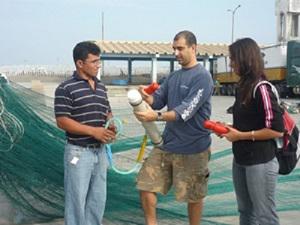Joanna Alfaro-Shigueto
Other projects
The high number of small cetaceans bycatch in artisanal gillnets off Peru, threatens the sustainability of these populations, but also on the fisheries itself. We aim to use existent mitigation methods to promote the sustainability of fishermen livelihoods and marine fauna.

The Netmark 1000 ‘pinger’ used in the study.
In Peru, small cetacean bycatch in Peruvian artisanal fisheries peaked in the late 1980’s and early 1990’s at approximately 15-20,000 animals annually. A national law banning dolphin capture, trade and consumption was implemented in 1995. However, through an onboard observer program in the artisanal fishery to assess the ban’s effectiveness, we have shown that the mortality rate and estimated total take of small cetaceans remain very high.

Deployment of the pingers at Salaverry port.
The fishing gear that causes the greatest impact is the artisanal driftnet for sharks and rays. This fishery primarily operates mainly from March through mid-September and the species impacted include the Burmeister’s porpoise, dusky dolphin, bottlenose dolphin and common dolphin.
Acoustic alarms (pingers) have shown to reduce the incidental capture rates of porpoises and dolphins. This proposed project is meant as a pilot test of pingers to be carried out in the shark gillnet fishery with the goal of determining pinger effectiveness as a deterrent for cetacean interactions. We will conduct this study from the port of Salaverry in northern Peru. Information on pinger performance will be collected by onboard observers placed on participating vessels and trained to record information on the fishing trip, set location, net characteristics, weather conditions, small cetacean interactions, target catch, and details of pinger deployment.
The overall goal of this project is to promote long term sustainability of small cetacean populations in Peru by reducing captures in artisanal gillnet fisheries. Our objectives include testing the effectiveness of acoustic alarms (pingers) on gillnet vessels at reducing small cetacean bycatch and continuing an outreach program with artisanal fishermen and government officials toward raising awareness of small cetaceans and the availability of bycatch mitigation measures. This project builds upon findings from our first RSG that small cetacean bycatch remains at a level of many thousands of animals per year of which about 50% are discarded dead.